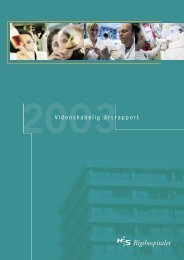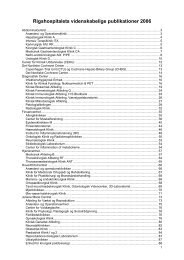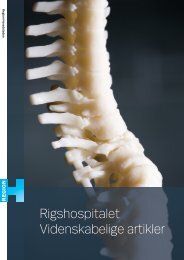View - CTU
View - CTU
View - CTU
You also want an ePaper? Increase the reach of your titles
YUMPU automatically turns print PDFs into web optimized ePapers that Google loves.
Bj'1mdal et al. 573<br />
level of endodontic<br />
ifact01)'<br />
No<br />
M F influence<br />
7 21 23<br />
96 86 24<br />
1 20<br />
0 19<br />
2 25<br />
14 10 19<br />
19 8 19<br />
15 19 26<br />
I infected root canal<br />
i the least influence<br />
rding to the GS.<br />
cantly higher influmales<br />
in relation to<br />
~tors: tooth type<br />
l status, fever and<br />
oth (ANOV A, P =<br />
0001). Females also<br />
f the apical foramen<br />
•utcome than males<br />
~ GDPs agreed with<br />
ences the treatment<br />
a significantly difd<br />
with the GS (Willer<br />
scored a higher<br />
shown by the negus<br />
of the pulp ( 'Y =<br />
atus ('/ = -0.12; P<br />
~s also assessed a<br />
Jintment dressing in<br />
: infected pulp ( 'Y =<br />
e of bacteria in the<br />
= -0.19; p = .004).<br />
1 endodontic<br />
ly endodontic visits<br />
1ce on the treatment<br />
relations in relation<br />
= .026), periapical<br />
1orking length ( 'Y =<br />
•s having relatively<br />
574 Bjf)mdal et al.<br />
more weekly endodontic VJSlts as opposed to GDPs<br />
having less (Wilcoxon test, P = .0043) agreed with the<br />
GS that tooth type had a relatively low influence on<br />
endodontic outcome.<br />
GDP self-assessments of the level of endodontic<br />
knowledge and skills<br />
In Table I, the self-assessment level of knowledge<br />
and clinical skills are displayed. The clinical skills<br />
were, in general, assessed by the vast majority of the<br />
GDPs as being excellent or satisfactory. The topic<br />
"microbiology" had the overall highest proportion of<br />
nonsatisfactory scores ( -40% ).<br />
Correlation analysis of the GDP sex and level of<br />
endodontic knowledge and skills<br />
Females as opposed to male GDPs did not find<br />
iliemselves at a satisfactory level concerning pulp pathology('/<br />
= 0.25; P < .010), injecting local anesthesia<br />
('Y = 0.23; P < .044; given the same graduation year),<br />
mechanical root canal preparation ('Y = 0.29; P < .003;<br />
given tile same graduation year and age), root-filling<br />
procedure('/ = 0.33; P < .0001), and knowledge about<br />
prognostic factors ('/ = 0.23; P = .008).<br />
Correlation analysis of the GDP graduation year<br />
and level of endodontic knowledge and skills<br />
The most recent educated GDPs found themselves at<br />
a satisfactory level concerning pulp pathology ( 'Y =<br />
-0.13; P = .023) and microbiology ('Y = -0.30; P =<br />
. 005), whereas injecting local anesthesia ('I = 0.30; P<br />
= .001) and performing emergency endodontics ('Y =<br />
0.40; P = .003) were nonsatisfactory.<br />
Correlation analysis of the GDP employment<br />
status and level of endodontic knowledge and<br />
skills<br />
Practice owners as opposed to associates assessed a<br />
higher satisfactory level in relation to microbiology ( 'Y<br />
= -0.30; P = .005), clinical diagnostics ('Y = -0.29;<br />
P = .005), emergency treatments ('Y = -0.30; P =<br />
.029), and injecting local anesthesia("/ = -0.41; P =<br />
.000).<br />
Correlation analysis of the GDP weekly working<br />
hours and level of endodontic knowledge and<br />
skills<br />
Knowledge of clinical diagnostic factors (irrespective<br />
of employment status) and prognostic factors were<br />
assessed higher by general dental practitioners working<br />
most hours per week than by GDPs working few hours<br />
per week('/ = -0.19; P = .013).<br />
OOOOE<br />
April 2007<br />
DISCUSSION<br />
The present study was part of a series of<br />
mvestJuations<br />
· ·<br />
0<br />
.<br />
attempting<br />
.<br />
to explore<br />
.<br />
factors iliat shape th<br />
e qua 1 -<br />
rty of endodontic treatment m general dental practice. It<br />
was understood that not only levels of techne but 1<br />
f . ·11 . fl aso<br />
o episteme WI exert m uence on clinical behavior.<br />
The idea tested was that there might be a distorted<br />
~pprehension among Danish GDPs of which factors are<br />
Important for the treatment outcome and that such a<br />
distortion might contribute to the acceptance of a hi uh<br />
rate of low-quality root fillings and symptomless pe~iapical<br />
lesions in root-filled teeth. A random sample of<br />
600 Danish GDPs was addressed. Questionnaires that<br />
were possible to analyze were returned by approximately<br />
75%, a rate high enough to make conclusions<br />
valid.I 7<br />
The GDP group response was compared with a GS.<br />
The GS was created by a consensus procedure among 7<br />
researchers who were assumed to have expert knowledge<br />
of the relevant literature. The highest number of<br />
significant differences between the GDPs and the GS<br />
were found among preoperative factors (Fig. 1). The<br />
GDPs did put weight on most of these factors, whereas<br />
the GS singled out 2 as the most influential: periapical<br />
status and root canal infection. In comparison with the<br />
GS, tile GDPs seem to overevaluate the importance of<br />
clinical symptoms such as pain, swelling, and the presence<br />
of a fistula. The focus on clinical symptoms was<br />
also observed among tile operative factors, where the<br />
evaluation of "no symptoms at the time of root filling"<br />
resulted in the only statistically significant difference in<br />
iliat group .<br />
Results from other studies support the idea that treatment<br />
initiation as well as acceptance of treatment outcome<br />
in general practice, to a great extent, is related to<br />
the presence or not of clinical symptoms. In 2 Swedish<br />
samples, Reit et al. I 8 and Karlsson and Reit 19 found<br />
that intracanal procedures most often were instituted to<br />
cure· symptoms like pain and tenderness in vital and<br />
necrotic pulps. At tile same time, retreatment of symptomless<br />
persistent periapical lesions in root-filled teeth<br />
was very rare. In concordance, Bj¢rndal et al. I 3 reported<br />
iliat endodontic treatment in Denmark most often<br />
was carried out in carious painful vital molars.<br />
Teeili with symptomless pathological conditions were<br />
infrequently negotiated.<br />
On the one hand, a high frequency of substandard<br />
root fillings has been registered in Denmark. 5 On the<br />
oilier hand, the present study showed that the Danish<br />
GDPs appreciated the importance of the technical rootfilling<br />
quality for the outcome of the treatment (Fig. 3),<br />
and that 94% regarded their level of endodontic skill as<br />
either excellent or satisfactory (Table I). In other words,<br />
Danish GDPs seem to know what they should do, think








